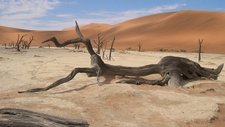Drought

TEKS Objective
The student is expected to describe environmental changes such as floods and droughts where some organisms thrive and others perish or move to new locations.
Essential Understanding
The student knows that organisms have characteristics that help them survive and can describe patterns, cycles, systems, and relationships within the environments.
Science Background
Drought: US Geological Survey (website) - Helpful facts, descriptions and graphics related to the causes, impacts, and usual locations of droughts, and ways to combat them.
Drought
US Geological Survey, www.usgs.gov
Drought for Kids: National Drought Mitigation Center (website) - Navigate this website for a large collection of useful information related to what a drought is, how drought affects our lives, how drought affects organisms, and how me can protect ourselves from drought. Includes a glossary and links to additional resources.
Drought for Kids
National Drought Mitigation Center, www.drought.unl.edu
Signature Lesson
Discovering Drought: Project WET (pdf) - A series of seven brief lessons describing climate conditions, cause and effect and conservation.
- Supporting Lessons
- Extensions
- Assessment Ideas
- Literature Connections
- Related
TEKS - Additional Resources
Supporting Lessons
Do Plants Need Water? Utah Education Network (website) - Plant lima beans at successively farther distances from a water source to observe the impact of water (or lack thereof) on plant growth. Focus on Investigation #1.
Do Plants Need Water?
Utah Education Network, www.uen.org
Droughts Lesson Plan: Australian Government, Emergency Management for Schools (website) - Investigate the Australian climate and water table, and the impacts of drought on people, wildlife and the environment.
Droughts Lesson Plan
Australian Government, Emergency Management for Schools, www.ema.gov.au
Elaboration Lessons and Extensions
Hot Weather, Rain Mean Fewer Pumpkins: Education World (website) - Download and print the article linked to this web page. Give each group of 3 or 4 students a copy of the article and a small pumpkin to observe. Have the groups read the article and discuss how drought is affecting the pumpkin crop. Then allow students to cut open their pumpkins to observe the insides. Cook the seeds and the pumpkin flesh and allow students to investigate the pumpkin using their sense of taste.
Hot Weather, Rain Mean Fewer Pumpkins
Education World, www.educationworld.com
Living Through a Drought: National Geographic (website) - Using a drought map of Afghanistan, students learn how to recognize drought, where drought can occur, and how drought affects people who live in drought-stricken places.
Living Through a Drought
National Geographic, www.nationalgeographic.com
Global Water Supply Elementary School Curriculum: Water.org (pdf) - Integrated unit on water use, lack of water and global outlook.
Global Water Supply Elementary School Curriculum
www.water.org
Assessment Ideas
Have students research animals, such as the turkey vulture or desert toad, that have specialized water-retaining adaptations. Then have each student write a paragraph that compares these animals to other, similar animals without the adaptations.
Literature Connections
Drought (Wild Weather, 2nd Edition). Chambers, Catherine (ISBN-13: 978-1403495761)
Witness to Disaster: Droughts. Fradin, Judy and Dennis (ISBN-13: 978-1426303395)
Saving Water (Water All Around). Olien, Rebecca (ISBN-13: 978-0736836999)
Droughts (Disasters Up Close). Woods, Michael (ISBN-13: 978-0822565765)
Additional Resources
Drought 101: National Geographic (video) - When changing weather patterns cause drought, the rains fail and the land, animals and people suffer a wide variety of problems, including severe water shortages and even death.
Drought 101
National Geographic, www.nationalgeographic.com
Drought in the Marsh: National Geographic (video) - As the Everglades suffer from drought, water levels drop and fish are forced to live into higher concentrations, causing the food chain to swing out of balance.
Drought in the Marsh
National Geographic, www.nationalgeographic.com
Surviving the Dust Bowl: PBS (video) - The story of farmers who moved to the southern plains of Texas, Oklahoma and Kansas seeking prosperity and a better life, but instead experienced ten years of drought, dust, disease and death.
Surviving the Dust Bowl
PBS, www.pbs.org
Drought Information for Kids: Delaware River Basin Commission (website) - Learn what droughts are, how to save water during a drought, and how droughts impact plants and wildlife.
Drought Information for Kids
Delaware River Basin Commission, www.state.nj.us/drbc/
TEKS Navigation
Grade 3
Need Assistance?
If you need help or have a question please use the links below to help resolve your problem.

Comments